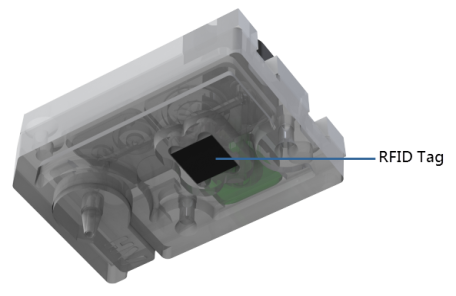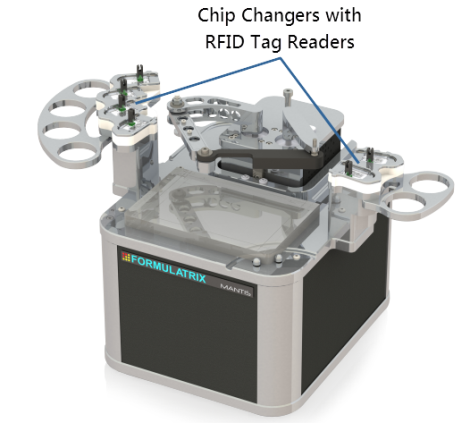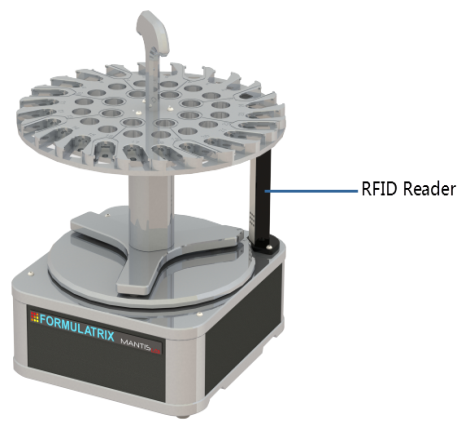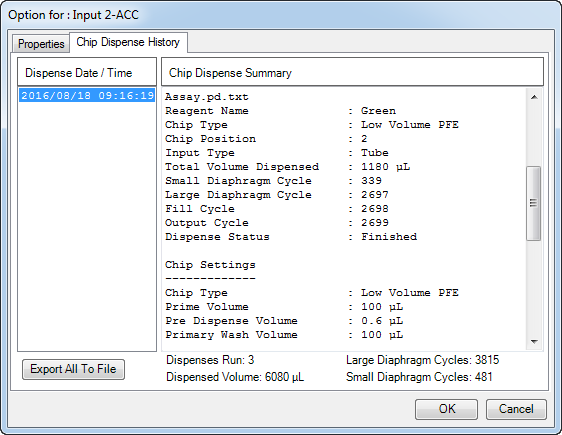

This MANTIS option uses a Radio-Frequency Identification (RFID) tag installed in each chip to provide helpful information about the chip usage and dispense process. The MANTIS instrument with RFID is fitted with six antennas for a faster RFID tag reading/writing process.

|

|
| MANTIS Chip With an RFID Tag | MANTIS RFID |

|
| LC3 Carousel with RFID Reader |
The following basic information is stored on each RFID chip itself:
| Option | Description |
|---|---|
| Chip Type | E.g. High Volume, Low Volume, PFE, 3PFE, or Continuous Flow. |
| Total Volume Dispensed | Total volume that this chip has dispensed to date. |
| Small Diaphragm Cycle | Total number of Small Diaphragm cycles to date. |
| Large Diaphragm Cycle | Total number of Large Diaphragm cycles to date. |
| Date of Manufacture | This chip’s manufacturing date. |
| Chip Serial Number | This chip's unique ID. |

Dispense History
After each dispense using an RFID chip, the following information will be stored directly onto your MANTIS database, tagged to the serial number of that chip.
| Option | Description |
|---|---|
| Dispense Date | Dispensing process date. |
| Protocol Name | Name of the protocol used for the dispensing process. |
| Dispense List Name | Name of the dispense list used for the dispensing process. |
| Plate Type | Plate type used for the dispensing process. |
| Reagent Name | Name of the reagent used during the dispensing process. |
| Chip Position Number | Chip station number in the Chip Changer or LC3 Carousel. |
| Input Type | Input source type, such as tube or pipette. |
| Total Volume Dispensed | Total volume that this chip has dispensed to date. |
| Small Diaphragm Cycle | Total number of Small Diaphragm cycles to date. |
| Large Diaphragm Cycle | Total number of Large Diaphragm cycles to date. |
| Fill Cycle | Total number of Fill Diaphragm cycles to date. |
| Output Cycle | Total number of Output Diaphragm cycles to date. |
| Dispense Status | Status of a dispensing process, whether it is finished or interrupted. |
| Prime Volume | Volume used for the priming process. |
| Pre-Dispense Volume | Volume used for the pre-dispensing process. |
| Primary Wash Volume | Volume used for the primary wash process. |
| Secondary Wash Volume | Volume used for the secondary wash process. |
| Recovery Volume | Volume used for the recovery process. |
| Wash After Dispense |
Wash behavior after the dispensing process. There are three kinds of behaviors:
|
| Chip Pressure | Chip pressure value. |
| Bottle Pressure | Bottle pressure value. |
| Chip Vacuum | Chip vacuum value. |
| Wash Pressure | Wash pressure value. |
| Wash Vacuum | Wash vacuum value. |
| Prime Pressure | Prime pressure value |
| Recovery Pressure | Recovery pressure value. |
| Recovery Vacuum | Recovery vacuum value. |

|
|
| MAC-V40R118 |